Hello, my gardening enthusiasts; are you ready to master this hobby with our meticulously crafted list of top gardening tools names? Do you know you can rev up and transform the entire outside and yard of your home with the right tools and mulch like wooden chips? A great set of tools not only helps you get most of your gardening jobs done but also helps you memorize the functions of each tool. So, are you confused about which tool to pick? What is the right set for your gardening needs? Or what is the right size? If these questions are popping up in your head and you want to save time, you have come to the right place. This article will cover some top chosen tools with the function of each tool explained. You can save research time by reading our article guide.
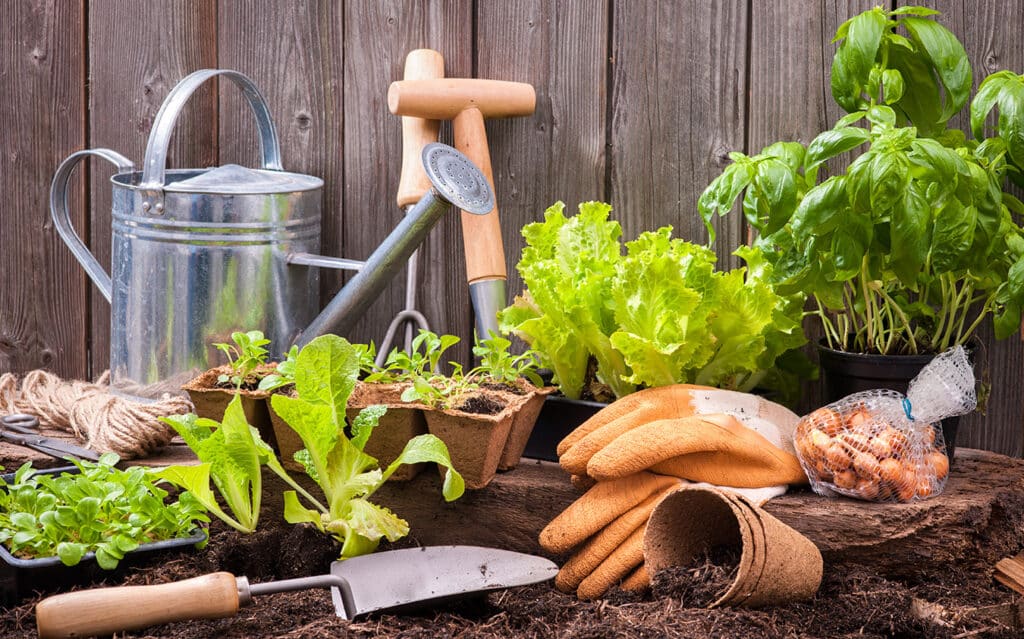
Green Thumb Essentials: 10 Must-Have Gardening Tools Names
You can transform your house’s backyard with a complete list of antique garden tools. Gardening is both an art and science of using the tools to dig up fertile soils. But nothing is worth it if you don’t know what function each tool performs. We understand your concern and are here to help you. From the magic of shovels to pruning tools and from garden forks to lawnmowers, memorizing and understanding gardening tool names is important. So, without further ado, let’s get right into the guide.
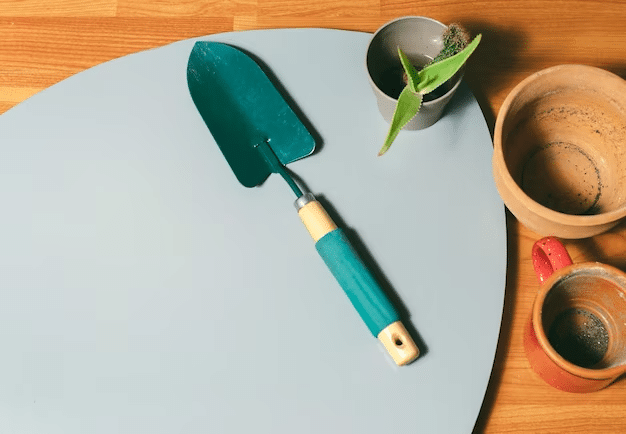
1: Digging Deeper: The Essential Hand Trowel in Your Gardening Arsenal
Among the list of gardening hand tools, the hand trowel is a classic, a multipurpose tool for a variety of garden tasks. This small tool, which looks like a tiny shovel, has a metal blade that is curved like a scoop and is fixed to a handle. This makes it ideal for small-scale planting, digging, and potting tasks. Because of the way it is built, gardeners can handle and use it comfortably, making tight spots easier to manage. In addition, the hand trowel’s durable construction guarantees longevity, making it a dependable partner for years of gardening explorations. But this little tool is strong and capable of handling duties like weeding, container gardening, and soil preparation with ease despite its diminutive size. Besides, the garden trowel is a handy addition to any gardener’s toolset due to its compact design.
Functions
- Planting
- Transplanting
- Digging
- Weed Control
- Soil Mixing
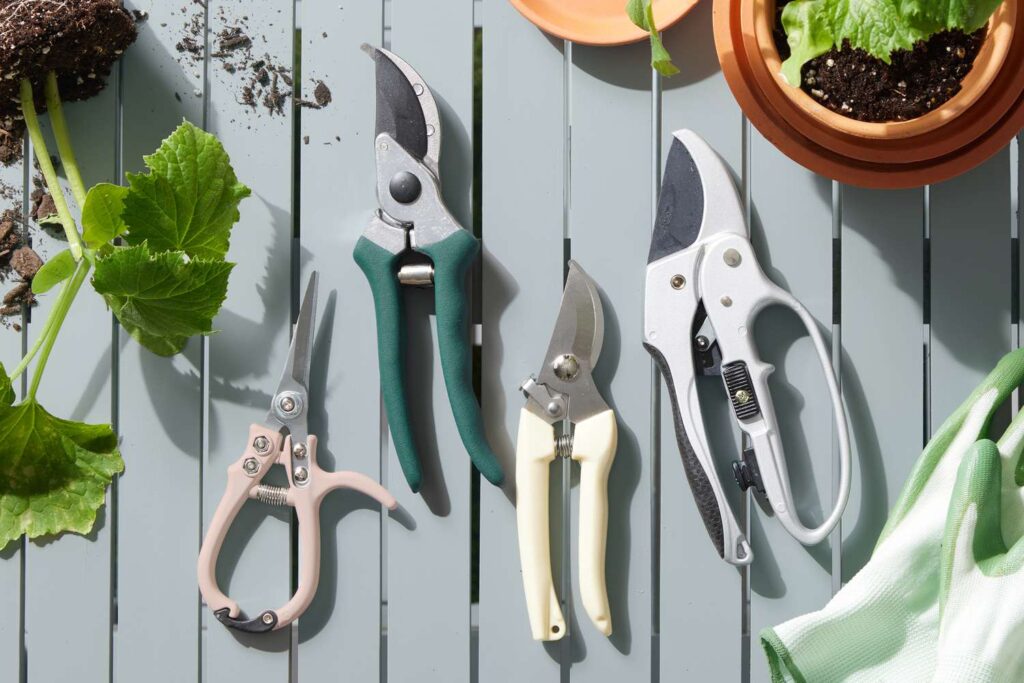
2: Gardening Tools Names: The Power of Pruning Shears (Secateurs)
Secateurs, another name for pruning shears, are an essential pruning tool in any gardener’s toolkit. You can easily trim, shape, and manage plants with these landscape tools. Their sharp edges allow for accurate cutting, encouraging robust development and enhancing the visual appeal of your garden. Moreover, pruning shears are available in a variety of styles and sizes to meet a range of pruning requirements, from delicate flower pruning to trimming larger branches. However, in addition to being useful for pruning, they can also be harvested for veggies and herbs. Among gardening tool names with pictures, pruning shears are an absolute necessity due to their sturdy construction and flexible handles.
Functions
- Cutting
- Shaping
- Cutting off heads
- Gathering
- Thinning
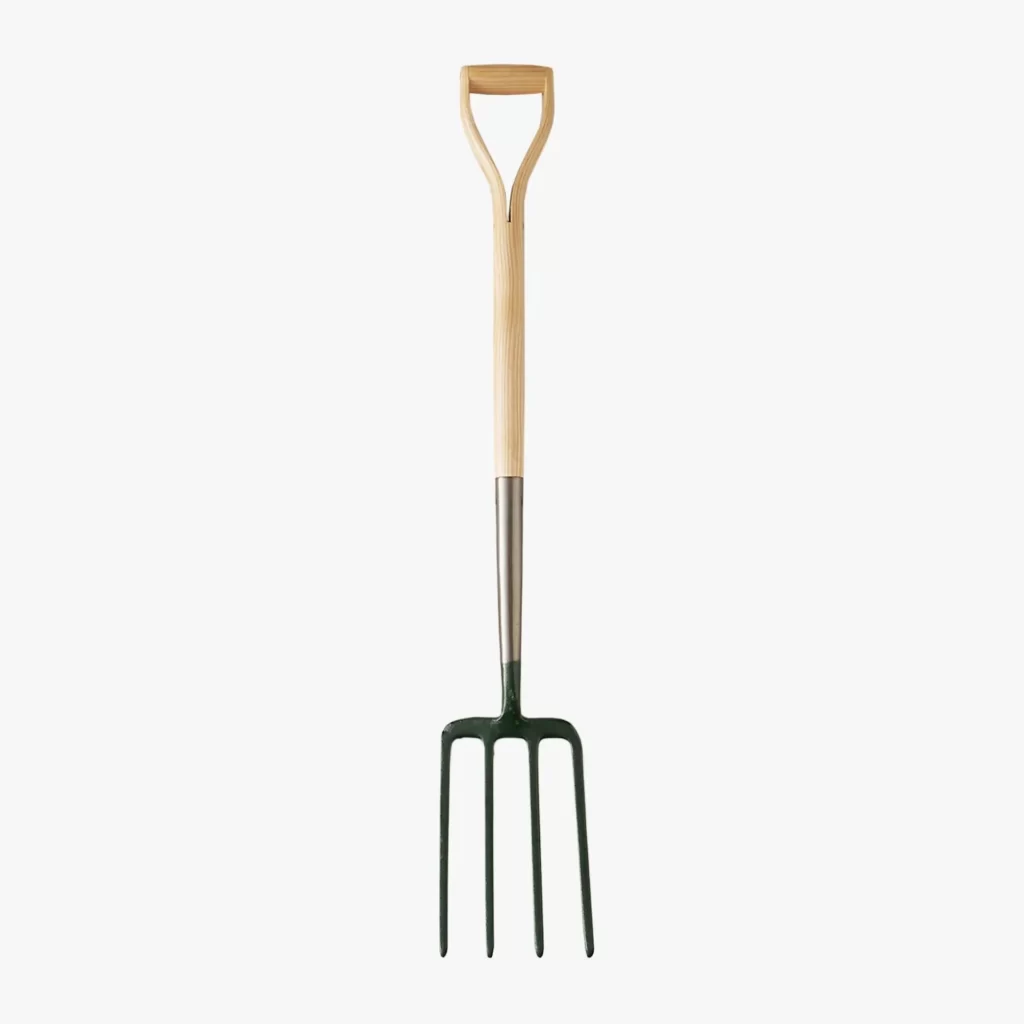
3: Unearth the Power: The Garden Fork Among Gardening Tools Names
Of all the fundamental garden tools with names, the garden fork is an all-time favorite due to its usefulness and flexibility. For any gardener, experienced or a novice, this tool is an essential item due to its strong tines and frequently long handles. Its main purpose is to air out and loosen the soil, which facilitates better root penetration and water absorption and helps plants grow.
In addition, the garden fork works well for scraping waste from plant beds, mixing soil additives, and stirring compost stacks. Yet an antique garden fork can be used for more than just gardening tasks; paired with other vintage tools, it can become a wonderful ornamental piece. Beyond its usefulness, the garden fork reflects the classic beauty of well-constructed tools, drawing gardeners closer to the soil with each shovelful and turn.
Functions
- Mixing compost
- Loosening compacted earth
- Aerating the soil
- Mixing soil amendments
- Cleaning Garden waste
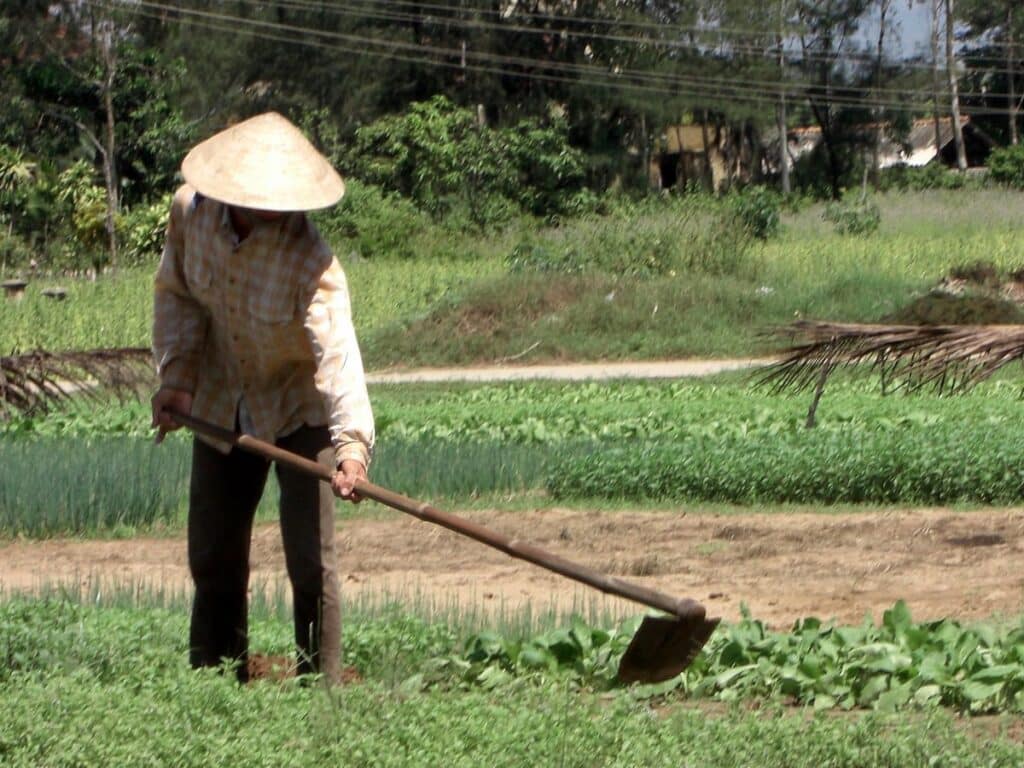
4: Harnessing the Power of the Hoe: A Key Player in Gardening Tools Names
The hoe is a vital tool for both novice and experienced gardeners among the essential garden tools. Its versatility comes from its ability to handle a wide range of tasks with ease. The hoe’s efficacy comes from its ability to quickly break up dirt, pull weeds, and develop garden beds in addition to its straightforward form. Additionally, there are other varieties of hoes available, like the Dutch hoe and the conventional flat hoe, each with a specific use in the art and science of gardening. Though the hoe seems simple, it takes technique to become proficient with it. To cut through weeds and loosen compacted soil, hold the handle firmly and tilt the blade downward. Regular use of hoe combined with additional tools such as the garden rake ensures a well-prepared garden bed, which creates an ideal environment for strong plant growth.
Different Types of Hoes
- Flat Hoe
- Dutch Hoe
- Warren Hoe
- Action Hoe
- Swan Neck Hoe
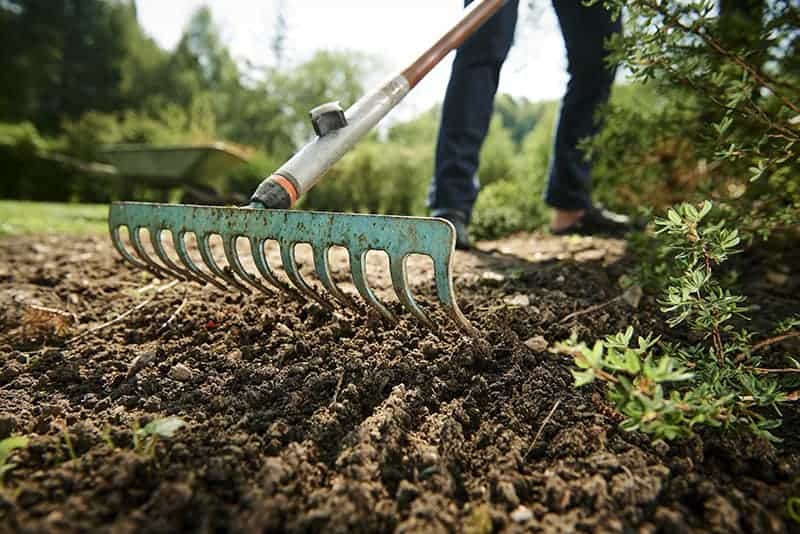
5: The Garden Rake: Unearth Your Garden’s Potential with a List of Gardening Tools Names
Next, the essential garden rake. This is the one gardening tool you need to keep your garden looking lush and healthy. This multipurpose tool is made of sturdy stainless steel and will last a long time in your gardening toolkit because it is resistant to rust and corrosion. With ease, it can remove waste, level the soil, and precisely distribute mulch or compost due to the strong tines on it. Besides, the garden rake works wonders at aerating the soil, which helps your plants expand their roots and absorb nutrients.
However, its usefulness doesn’t stop with soil management; it could also serve as a useful tool for collecting leaves and grass clippings, making yard upkeep easier. With just a slight amount of pressure applied to the curved handle, you can quickly create a neat and ready-made garden bed by raking through the dirt or debris.
Functions and Uses
- Leveling the Soil
- Removal of Debris
- Distribution of Mulch
- Aeration of Soil
- Gathering leaves
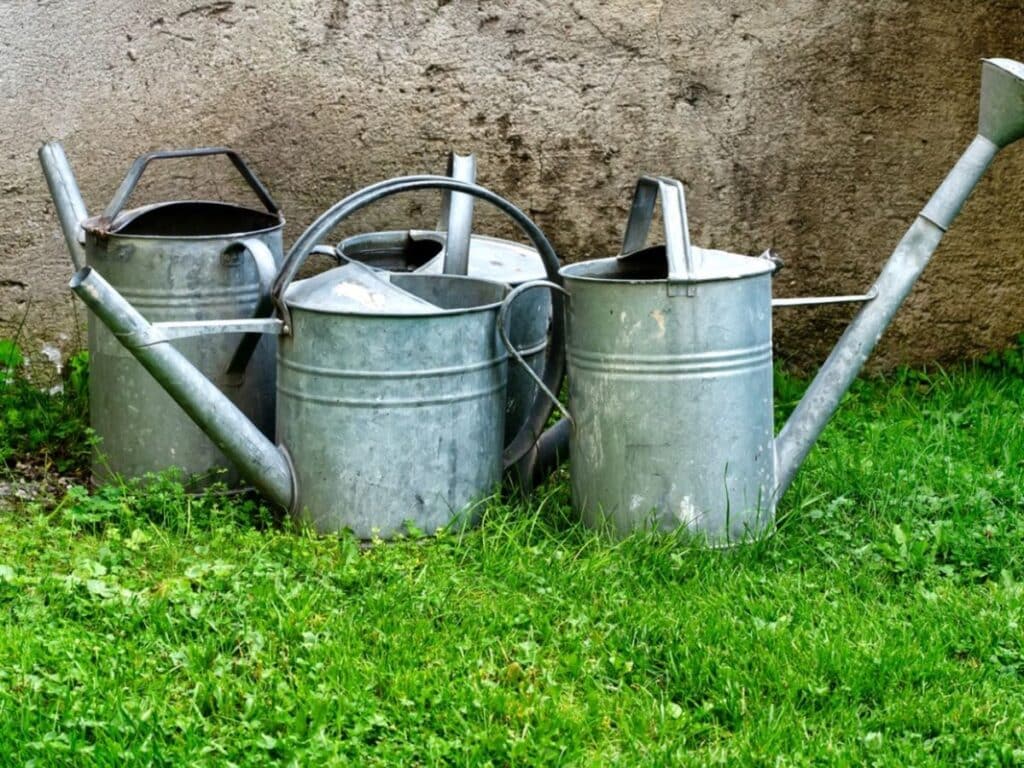
6: Watering Can or Hose
The unsung hero of any flourishing garden is a garden hose or watering can, aside from the variety of power tools in your shed. The longest gardening tool name, the garden hose, is flexible and long-reaching, perfect for watering plants across wide areas. It’s easy to use; just attach it to a water source, change the nozzle’s setting to get the right spray, and wash it away. However, standard watering can be used for finer plants and targeted watering.
With its exact pouring, you can minimize waste and prevent overwatering by accurately directing water where it’s needed. Moreover, you can carefully take care of seedlings and recently planted flowers with a watering can. For a rich, flourishing garden, both the powerful garden hose and a small watering can are essential equipment.
Uses
Garden Hose
1. Versatility: The garden hose can be used for more than just watering; it can also be used for cleaning and filling.
2. Long-Range Watering: Its length enables wide outdoor areas to be watered.
3. Adjustable Nozzle: You can control the water pressure and flow by adjusting the hose’s nozzle.
4. Efficiency in Time: It quickly and effectively waters large areas.
Watering Can
1. Precision Watering: Minimizes water waste by accurately delivering water to plant bases.
2. Perfect for Sensitive Plants: Its mild flow is appropriate for sensitive seedlings and plants with shallow roots.
3. Controlled Watering: This method limits the amount of water used in order to avoid overwatering.
4. Indoor Use: Offers a measured approach to watering, useful for indoor plants.

7: Guardian Gloves: Essential Gear Among Gardening Tools Names
Garden gloves are needed since they protect and soothe hands while working in the garden. In addition to protecting wounds, blisters, and thorns, they guarantee a solid hold on instruments such as the garden spade, improving both precision and safety. These gloves also safeguard against moisture and dirt, keeping hands dry and clean throughout gardening activities. Just put these on before handling any gardening tools to use them properly. But it’s important to select gloves that fit properly and provide enough dexterity to perform activities with ease. Additionally, for long-lasting performance, choose sturdy materials like leather or synthetic textiles. Garden gloves are an essential tool for any gardener, providing a safe and enjoyable gardening experience when used and maintained properly.
Functions
- Conversion and Planting
- Soil aeration
- Pruning
- Weeding
- Harvesting
- Protection Against Bristles and Scrapes

8: Garden Spade: Lush Green Gardens with Gardening Tools Names
When it comes to landscape tools, the garden spade is a silent hero and a reliable ally in the gardener’s pursuit of horticultural excellence, where each turn of the earth reveals a new tale. The garden spade is a smart tool, expertly crafted to gently shape the earth, in contrast to its larger cousin, the shovel. Its thin shape masks its strength since it can expertly rip through the dirt. The list of gardening tool names frequently reflects its importance because it is a means of allowing dreams to flourish rather than just a simple tool. The garden spade also functions as an artist’s brush, sculpting the garden landscape in addition to its primary function of digging and planting. But mastery of this tool required more than power; it takes skill, persistence, and a profound respect for the mysteries of the ground.
Uses and Functions
- Digging: The garden spade is an excellent tool for creating planting holes for vegetables, flowers, shrubs, and trees.
- Edging: Its flat, sharp blade is perfect for cutting neat margins on grass borders, flower beds, and walkways.
- Lifting: Move small plants, dirt clumps, or other garden waste with the spade.
- Mixing Soil: In addition to digging, the spade works well for incorporating fertilizer, compost, and soil additives into the ground.
- Separating Plants: The spade’s sharp blade is useful for splitting perennials and separating densely packed plants.
- Soil Loosening: Compacted soil can be broken up with a shovel to improve aeration and root development.
- Removing Weeds: Lift out weeds with the spade as little change to the soil as possible, especially those with deep taproots.
- Sod Cutting: When creating new planting areas or paths, it can be used to cut and remove sod patches.
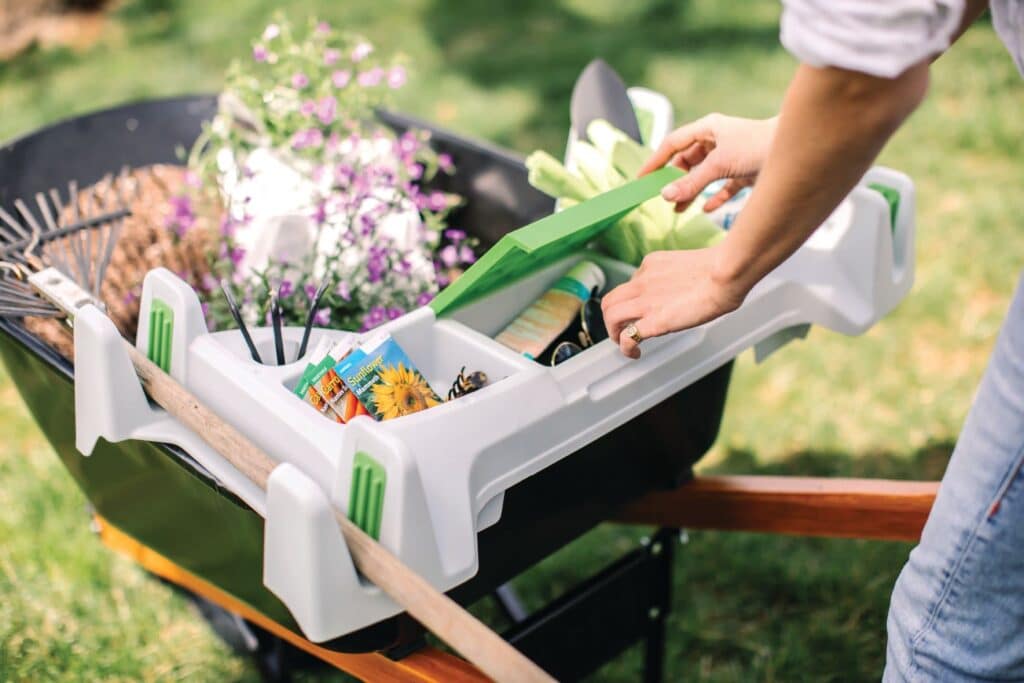
9: Rolling Essential: The Wheelbarrow – Gardening Tools Names
A gardener’s armory would not be complete without a wheelbarrow due to its vital versatility and effectiveness. This simple yet sturdy cart has handles and a shallow container that are held aloft by one wheel. Its main purpose is to easily move large loads of mulch, plants, dirt, or gardening equipment across the garden. For large-scale material carrying, pruning tools and power tools are frequently excessively heavy. Thus, a wheelbarrow is an indispensable piece of equipment for garden upkeep.
Moreover, the form of the wheelbarrow makes it easy to maneuver even in uneven or narrow places. But the benefits go beyond just ease of transportation. In addition, gardeners can use it as a temporary mixing station or workbench for potting plants or making soil supplements. In addition, its robust design guarantees longevity, and its rubber wheels offer steady and seamless mobility. The wheelbarrow is a symbol of all things practical and convenient, which are necessary for any garden to thrive.
Functions and Uses
- Transportation: Wheelbarrows make gardening chores like bed preparation and maintenance easier by efficiently moving bulky items like mulch, dirt, and equipment throughout the garden.
- Aeration and Soil Preparation: By distributing nutrients uniformly throughout the garden beds, they help turn and aerate the soil, ensuring its fertility and health.
- Compost Management: Gardeners can conveniently carry organic matter to compost piles and help in the decomposition process by using wheelbarrows to gather and handle compost materials.
- Harvesting: Wheelbarrows are ideal for gathering gathered produce because of their roomy containers, which prevent fragile fruits and vegetables from bruising while being transported.
- Multipurpose Workstation: Wheelbarrows are multipurpose workstations that offer an easy way to pot plants, mix soil additives, and arrange tools, all while improving productivity and neatness in the garden.
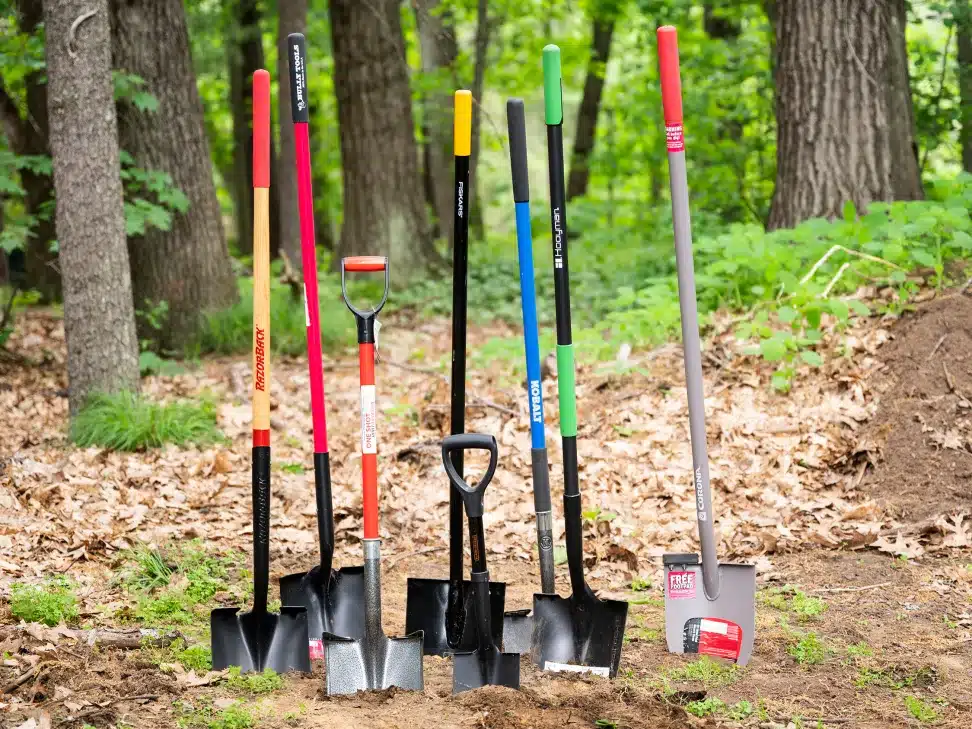
10: Groundbreaker: Unearthing the Magic of Shovels in Your Gardening Tools Names
A staple in every gardener’s toolbox, the shovel is valued for its strength and versatility. It is essential for jobs like planting, transplanting, and constructing garden beds because of its strong steel blade, which is made for lifting, digging, and moving soil. But the shovel’s usefulness goes beyond digging; it’s also excellent for activities like mulch spreading, compost mixing, and waste clearance. Its ergonomic design, which includes a long handle for leverage, also lessens the strain on the user’s arms and back, allowing for longer use without experiencing any discomfort. To effectively use the shovel, just take a firm grip on the handle, place the blade where you want it, and then press down with your foot to push the shovel into the ground. After that, use the handle to raise and rotate the soil as necessary.
Functions
- Excavating planting holes
- Putting in small shrubs
- Transferring compost and soil
- Digging irrigation trenches
- Removing rocks and debris
However, if you want to learn more about gardening tools, check out Alyssa’s blog.
Conclusion
In summary, the secret to renovating your outside space is to become proficient with the names and functions of gardening tools. Every tool is critical to maintaining a healthy garden, from the hand trowel that is used for exact planting to the shovel that can be used for a variety of chores, including mixing compost and moving dirt. A lush, colorful garden sanctuary is something you can make with the right tools.
Green Dreams Bloom with Gardening Tools Names!
